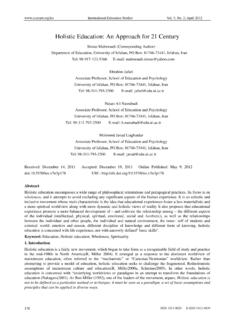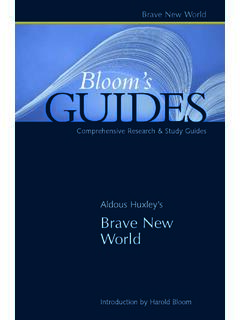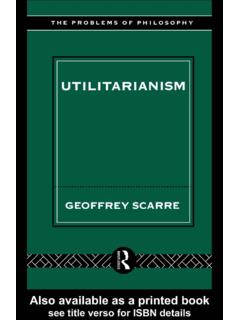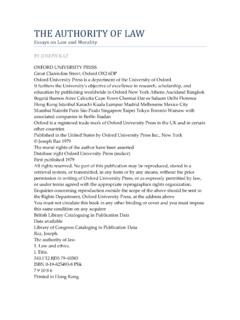Transcription of TEACHING PHILOSOPHY – Sample 1
1 TEACHING PHILOSOPHY Sample 1 My general TEACHING focus at university is to promote learning by engaging students in their learning environment, promoting higher order thinking skills and respecting their opinions and backgrounds. I developed my respect for education and passion for TEACHING at a very early age in my life. My mother, an academic, planted the commitment to lifelong learning. My father, a military veteran, nourished this commitment with a sense of responsibility and respect to others. I began to teach at an early age as I was entering my undergraduate studies in the Faculty of Engineering.
2 My TEACHING was related to the community with a focus on TEACHING young girls living in rural areas and villages the value of education. I prepared materials, organized day trips and overnight conventions. These opportunities where rarely available for kids and youth in these communities and if it was available it would be only for the boys. My TEACHING PHILOSOPHY when I started was based on respecting my young students and providing methods and tools that could help them in being independent and thus able to make the right decisions in the future. As the years passed, I discovered that TEACHING and learning is a two-way process; the more I teach, prepare for my classes and engage with my students the more I learn.
3 As they grew my focus shifted to mentor volunteers and guide them through reviewing and enhancing their TEACHING practices to reach out to vulnerable girls in their community. The curriculum that I designed encouraged creative TEACHING approaches developed collaboratively with the new teachers. During the weekly classes, I emphasized the importance of team work and mutual respect. Through my passion about the subject, I was able to engage my students in an enjoyable learning experience. As a teacher, I learned from my students. I challenged them and focused on helping them how to learn.
4 I entered the workforce in higher education, and I continued to carry with me the commitment to better education and respect for my students knowledge and experience. My TEACHING PHILOSOPHY evolved, to include applying principles and theories that relate to adult learning and constructivism. The constructivist theory explains that learning happens by creating a meaning from experience and what the learner knows is based on his/her own experience (Ertmer & Newby, 1993). Furthermore, in adult learning theories, the learner is involved and takes responsibility of his/her learning process.
5 The learners self-reflect, gather information, collaborate with others and are self-directed (Conlan, Grabowski & Smith, 2003). In recognizing how adult learners perceive education, I incorporated in my TEACHING case studies and real life examples. See example 5 in Appendix (B) for an in class activity based on a case study. In my current work environment, my students are highly educated and professional adults and I became more of a facilitator. In this role, my goal is to help the learners to analyze, evaluate and critically reflect on their own experiences rather than simply transfer knowledge.
6 To achieve this goal, I have designed activities that could facilitate their learning in both face-to-face and online environments. For example, I have developed a workshop on facilitating group work among students; the workshop includes a group activity in which participants share their own experiences with groups and provide recommendations to the participants. The outcomes of the workshop became a knowledge base for subsequent workshops and resources for participants who did not attend the workshop; see Appendix (B) for examples of the course outline including activities.
7 As a facilitator of the Instructional Skills Workshop (ISW), a peer based international certificate program that help educators in improving their instructional and presentation skills, I work closely with the participants to help them in articulating their own TEACHING goals. During the three-day intensive workshop, I work one-on-one with the participants to overcome their own challenges and fears and boost their confidence. Moreover, I provide a safe environment for the participants to exchange ideas and provide efficient and constructive feedback. I have redesigned the workshop to offer in a hybrid format.
8 Through activities and resources participants interact with each other, with the facilitator and the content in engaging and effective ways - these are three import elements in promoting students engagement (Dashew & Lee, 2011). Appendix (B) provides the course outline. Participants found the online modules very engaging, well structured and very useful; see Appendix (C) for detailed evaluation data. With my background in software programming, graduate studies in instructional design, technology and online learning, and experience in project management, I use technology as a means to facilitate my own learning.
9 Through my learning networks, twitter and personal blog, I participate in open dialogue with experts in the technology field. Similarly in my TEACHING , I encourage my students to explore new tools that could help them effectively collaborate and present their work. For example, I offered a workshop on Google Drive, I was able to help participants to practice the use of the tool, answer their questions and promote self exploration. With a focus on higher order thinking skills, my TEACHING strategies promote students critical thinking in self-directed and safe learning environments.
10 Another focus in my TEACHING is to I incorporate the Universal Design for Learning Principles (UDL) in my course outlines and TEACHING . The outlines provide clear expectations, objectives and list of related assignments; example 3 in Appendix (B) provides an example of a rubric to help students understand the expectations for the assignments and activities. I align the assessment with the course objectives and provide multiple means of representation for the contents, including audio, video and multimedia components which follow the recommendations of UDL principles.










